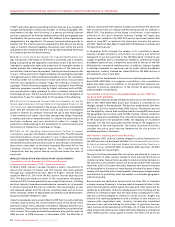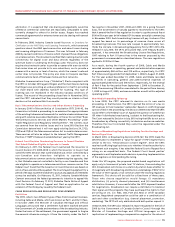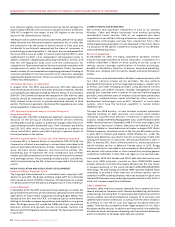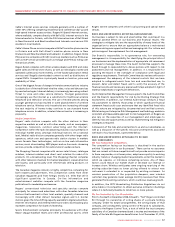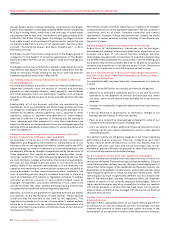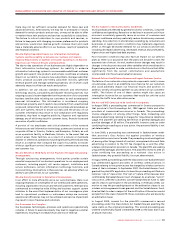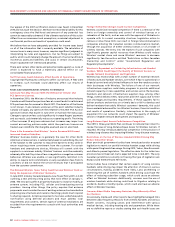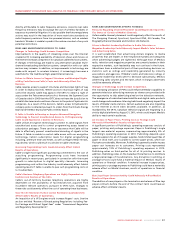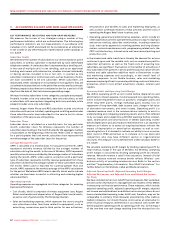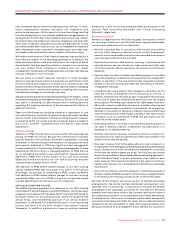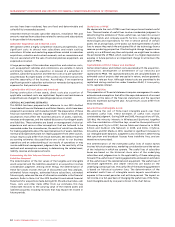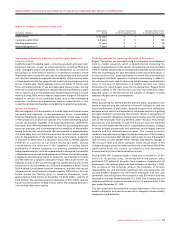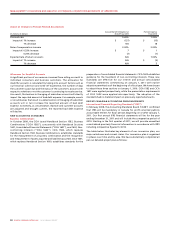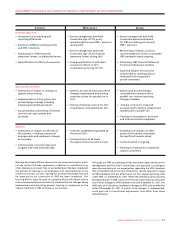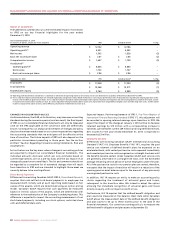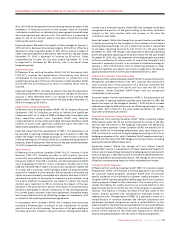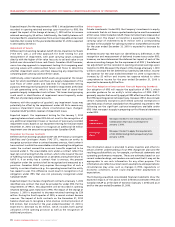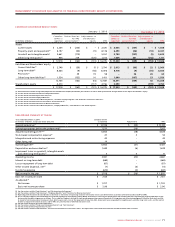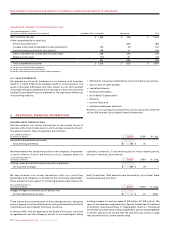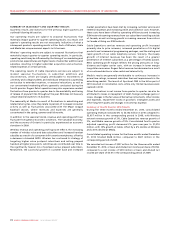Rogers 2010 Annual Report Download - page 60
Download and view the complete annual report
Please find page 60 of the 2010 Rogers annual report below. You can navigate through the pages in the report by either clicking on the pages listed below, or by using the keyword search tool below to find specific information within the annual report.
MANAGEMENT’S DISCUSSION AND ANALYSIS OF FINANCIAL CONDITION AND RESULTS OF OPERATIONS
64 ROGERS COMMUNICATIONS INC. 2010 ANNUAL REPORT
services have been rendered, fees are fixed and determinable and
collectibility is reasonably assured.
Unearned revenue includes subscriber deposits, installation fees and
amounts received from subscribers related to services and subscriptions
to be provided in future periods.
Subscriber Acquisition and Retention Costs
We operate within a highly competitive industry and generally incur
significant costs to attract new subscribers and retain existing
subscribers. All sales and marketing expenditures related to subscriber
acquisitions, retention and contract renewals, such as commissions and
the cost associated with the sale of customer premises equipment, are
expensed as incurred.
A large percentage of the subscriber acquisition and retention costs,
such as equipment subsidies and commissions, are variable in nature
and directly related to the acquisition or renewal of a subscriber. In
addition, subscriber acquisition and retention costs on a per-subscriber-
acquired basis fluctuate based on the success of promotional activity
and the seasonality of the business. Accordingly, if we experience
significant growth in subscriber activations or renewals during a period,
expenses for that period will increase.
Capitalization of Direct Labour and Overhead
During construction of new assets, direct costs plus a portion of
applicable overhead costs are capitalized. Repairs and maintenance
expenditures are charged to operating expenses as incurred.
CRITICAL ACCOUNTING ESTIMATES
This MD&A has been prepared with reference to our 2010 Audited
Consolidated Financial Statements and Notes thereto, which have been
prepared in accordance with Canadian GAAP. The preparation of these
financial statements requires management to make estimates and
assumptions that affect the reported amounts of assets, liabilities,
revenues and expenses, and the related disclosure of contingent assets
and liabilities. These estimates are based on management’s historical
experience and various other assumptions that are believed to be
reasonable under the circumstances, the results of which form the basis
for making judgments about the reported amounts of assets, liabilities,
revenue and expenses that are not readily apparent from other sources.
Actual results could differ from those estimates. We believe that the
accounting estimates discussed below are critical to our business
operations and an understanding of our results of operations or may
involve additional management judgment due to the sensitivity of the
methods and assumptions necessary in determining the related asset,
liability, revenue and expense amounts.
Determining the Fair Values of Assets Acquired and
Liabilities Assumed
The determination of the fair values of the tangible and intangible
assets acquired and the liabilities assumed in an acquisition involves
considerable judgment. Among other things, the determination of
these fair values involves the use of discounted cash flow analyses,
estimated future margins, estimated future subscribers, estimated
future royalty rates and the use of information available in the financial
markets. Refer to Note 4 of the 2010 Audited Consolidated Financial
Statements for acquisitions made during 2010. Should actual rates, cash
flows, costs and other items differ from our estimates, this may
necessitate revisions to the carrying value of the related assets and
liabilities acquired, including revisions that may impact net income in
future periods.
Useful Lives of PP&E
We depreciate the cost of PP&E over their respective estimated useful
lives. These estimates of useful lives involve considerable judgment. In
determining the estimates of these useful lives, we take into account
industry trends and company-specific factors, including changing
technologies and expectations for the in-service period of certain
assets. On an annual basis, we re-assess our existing estimates of useful
lives to ensure they match the anticipated life of the technology from a
revenue-producing perspective. If technological change happens more
quickly or in a different way than anticipated, we might have to reduce
the estimated life of PP&E, which could result in a higher depreciation
expense in future periods or an impairment charge to write down the
value of PP&E.
Capitalization of Direct Labour and Overhead
Certain direct labour and indirect costs associated with the acquisition,
construction, development or betterment of our networks are
capitalized to PP&E. The capitalized amounts are calculated based on
estimated costs of projects that are capital in nature, and are generally
based on a rate per hour. Although interest costs are permitted to be
capitalized during construction under Canadian GAAP, it is our policy
not to capitalize interest.
Accrued Liabilities
The preparation of financial statements requires management to make
estimates and assumptions that affect the reported amounts of accrued
liabilities at the date of the financial statements and the reported
amounts expensed during the year. Actual results could differ from
those estimates.
Amortization of Intangible Assets
We amortize the cost of finite-lived intangible assets over their
estimated useful lives. These estimates of useful lives involve
considerable judgment. During 2004 and 2005, the acquisitions of Fido,
Call-Net, the minority interests in Wireless and Sportsnet, together
with the consolidation of the Blue Jays, as well as the acquisitions of
Futureway and Citytv in 2007, Aurora Cable and channel m in 2008,
K-Rock and Outdoor Life Network in 2009, and Blink, Cityfone,
Kincardine and BV! Media in 2010, resulted in significant increases to
our intangible asset balances. Judgment is also involved in determining
that spectrum and broadcast licences have indefinite lives, and are
therefore not amortized.
The determination of the estimated useful lives of brand names
involves historical experience, marketing considerations and the nature
of the industries in which we operate. The useful lives of subscriber
bases are based on the historical churn rates of the underlying
subscribers and judgments as to the applicability of these rates going
forward. The useful lives of roaming agreements are based on estimates
of the useful lives of the related network equipment. The useful lives of
wholesale agreements and dealer networks are based on the
underlying contractual lives. The useful life of the marketing agreement
is based on historical customer lives. The determination of the
estimated useful lives of intangible assets impacts amortization
expense in the current period as well as future periods. The impact on
net income on a full-year basis of changing the useful lives of the finite-
lived intangible assets by one year is shown in the chart below.


